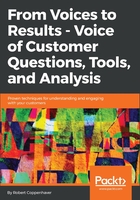
Chapter 2. VoC in the Product Development Process
"Your opinion, although interesting, is irrelevant..." |
||
| --"Tuned In" | ||
Most organizations have some sort of a process to develop products. Often, it is called a new product development (NPD) process or a new product innovation (NPI) process. Whatever your organization calls it, it is intended to guide the organization and development team from the beginnings of an idea through development, and ultimately, to the launch of the product and revenue generation. In some cases, there are very formalized approaches to this process, such as stage gate, agile, iterative, waterfall, and others. And in some cases, there is nothing more formalized than a spreadsheet or calendar system.
In organizations where VoC is used, most people would accept that VoC is a valuable input to the marketing requirements portion of the development. Far fewer people understand how VoC can be a key input to the product development process at every stage of the product's development, and how it allows an organization to better serve their market and be more responsive to changes in their marketplace. In this chapter, we will show you how to leverage VoC at every stage of the new product development, giving your product a much higher probability of success.
Where does VoC fit in the product development process?
If you ask a typical product manager or business owner where VoC is used within their development process, they will typically highlight the following two key areas:
- Idea generation: Interacting with customers through interviews, as well as focus groups, to determine customer-generic needs and problems, and actively soliciting ideas from innovative and lead users during what is often referred to as the fuzzy front end (FFE) stage.
- Design phase of the product: Determining customer and user requirements with a user needs-and-wants study. Typically, this entails interviewing and listening to the customer or user to understand his/her problems and to determine both articulated and unarticulated needs, wants, and desires.
While this is not incorrect, customer input should not stop at the completion of the ideation or predevelopment market study phases of the project, but rather the customer input needs to be incorporated at all phases of the product development plan. While quality customer input is a critical piece of the upfront work, seeking customer input at critical stages of the development via concept tests, prototypes, beta trials, and other methods will also play a large role in the success in the new product innovation process.
Early customer input is critical to creating a successful product design. Multiple studies show the link between solid, up-front customer interaction and market analysis when creating a winning product. Successful firms tend to spend about twice as much time and money on the following critical up-front activities augmented by solid VoC:
- Initial screening: The first decision to enter into the project
- Preliminary market assessment: A first-pass market study
- Preliminary technical assessment: A first pass assessment of the technical complexity and the risk of undertaking the project
- Detailed assessment: A detailed market study including primary research with customers through VoC, as well as secondary research
- Business case: An analysis of the market potential, costs, and resource requirements needed to complete the development
As we have discussed earlier, a common complaint is that homework slows down the development process. Of course, the evidence points to a very different conclusion as studies have shown that if the homework is omitted, there is a much higher likelihood of product failure and the need to redesign the product. The additional time spent on project definition in this phase actually speeds up the development process by reducing the slippages caused by vague product requirements and unanticipated issues.